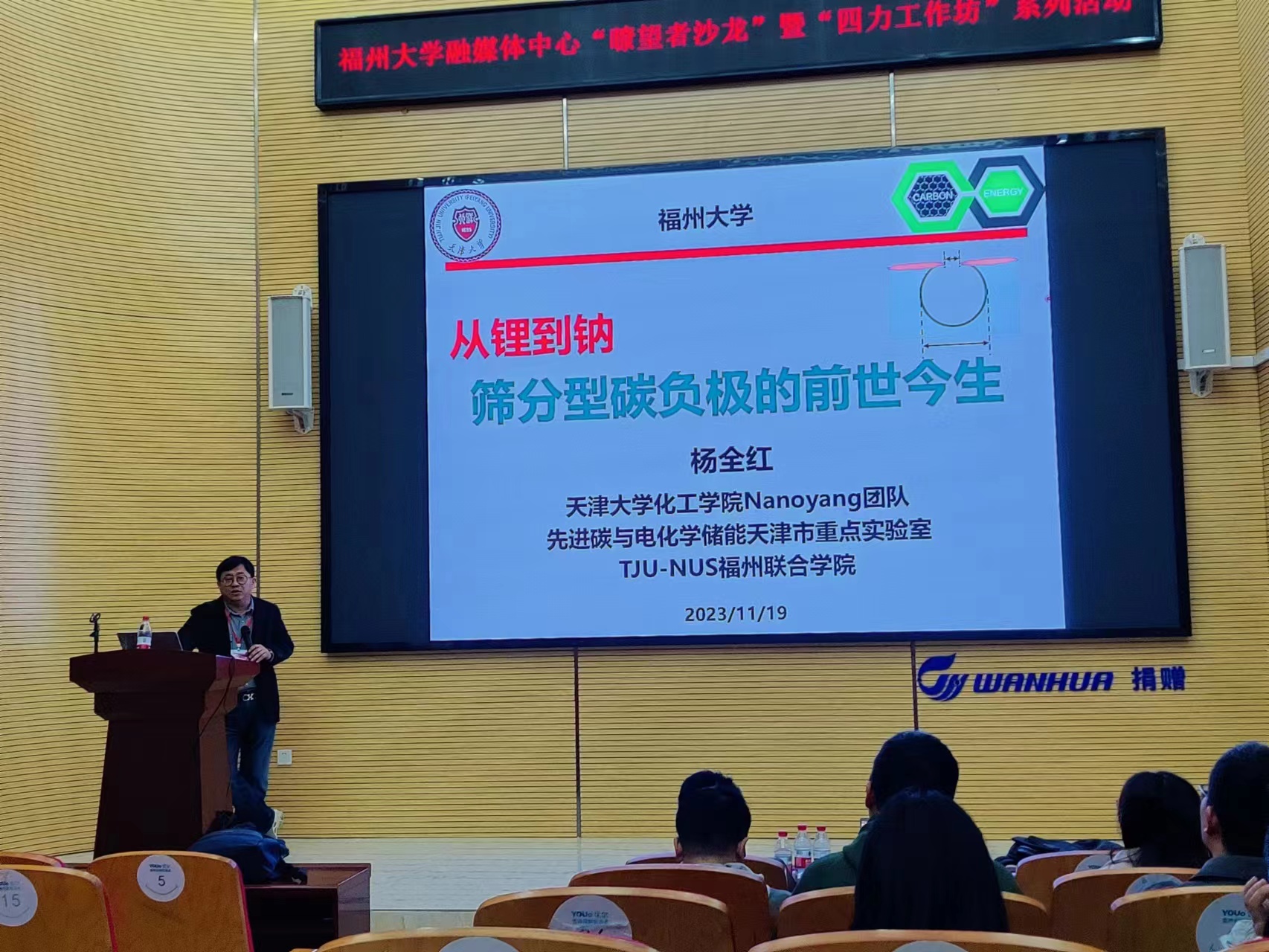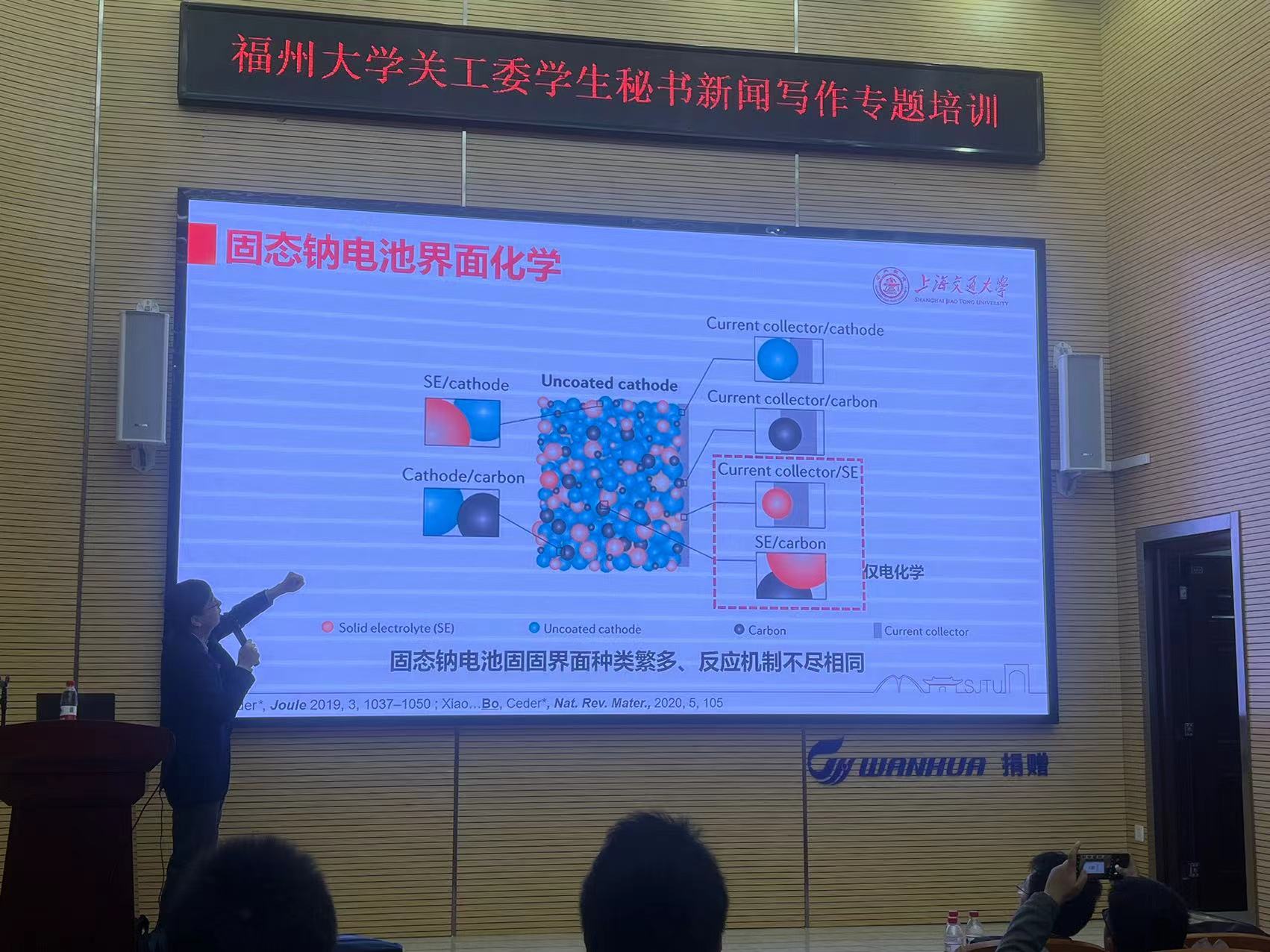On November 19, 2023, Professor Yang Quanhong from Tianjin University and Professor Bo Shouxing from Shanghai Jiao Tong University were invited by Professor Tang Yuxin from the College of Petrochemical Engineering at Fuzhou University for an exchange and visit to their research group. They delivered fascinating academic presentations titled "From Lithium to Sodium: The Past and Present of Screened Carbon Anode" and "Interface Force-Electrochemical Coupling Mechanism in All-Solid-State Sodium Batteries" at Room 101 in Quangang Building, attracting faculty and students alike.
Professor Yang Quanhong provided a detailed introduction to the research on screened carbon, which originated from the study of molecular sieve carbons that precisely separate oxygen and nitrogen. This special carbon material structure possesses excellent selective adsorption abilities, enabling efficient screening of molecular-level solvents and ions. In sodium-ion batteries, the screening effect of solvent molecules and the desolvation effect of sodium ions are crucial for enhancing Coulombic efficiency. Traditional carbon anode materials often exhibit strong interactions with solvents, making it difficult for sodium ions to be released and adsorbed, thereby reducing the battery's efficiency. Screened carbon, with its unique structure and chemical properties, effectively addresses this issue by offering strong screening and desolvation effects.
Regarding the progress of screened carbon, Professor Yang Quanhong proposed a customized structure aimed at achieving a low-potential plateau and extended capacity. Through the implementation of interface engineering, the interaction between the battery material and electrolyte can be controlled, further enhancing Coulombic efficiency and platform capacity. Interface engineering forms a molecular barrier on the surface of screened carbon, inhibiting the strong interaction between solvent molecules and carbon materials. As a result, sodium ions can more freely insert into and extract from screened carbon during the charge and discharge process, thereby improving the battery's efficiency and capacity. Additionally, Professor Yang Quanhong achieved a low-potential plateau by manipulating the pore size and porous structure of screened carbon. Through the rational design of carbon material's porous structure, more sodium insertion sites can be provided, delaying the capacity decay of the battery, and ultimately improving cycling life and capacity stability.
In conclusion, screened carbon serves as an ideal structural model for the carbon anode in sodium-ion batteries, possessing unique molecular sieving selectivity and desolvation effects, which enhances Coulombic efficiency and capacity in sodium batteries. By employing strategies such as interface engineering and porous structure manipulation, the performance of the carbon anode can be further optimized, thereby promoting the application of sodium-ion batteries in the field of energy.

Lecture scene
Professor Bo Shouxing discussed the development trend of commercial secondary batteries, highlighting the importance of solid-state sodium batteries as a future direction. However, various solid-solid interfaces and different reaction mechanisms complicate solid-state sodium batteries. Furthermore, the thermodynamic stability window of sulfide solid electrolytes is relatively narrow. Therefore, Professor Bo Shouxing emphasized the need to develop high-throughput thermodynamic calculation methods to rapidly and accurately determine the reaction products and reaction energies of interface reactions. In his research, Professor Bo Shouxing found that NaCrO2 and phosphate-based cathodes exhibited good compatibility with solid electrolytes. Based on the Monroe-Newman model, he further developed a force-electrochemical coupling model for the metal anode/solid electrolyte interface. Additionally, his research group prepared salt-free ceramic composite solid electrolyte films through a two-step hot pressing method, providing new insights for the development of solid electrolytes.

Lecture scene
The presentations by Professor Yang Quanhong and Professor Bo Shouxing captivated the attendees, arousing their curiosity and desire for exploration. Participants actively engaged in the discussion session, and fruitful exchanges with Professor Yang Quanhong and Professor Bo Shouxing deepened their understanding of related research fields. This interaction not only strengthened mutual understanding but also promoted academic collaboration and discipline development.
This exchange activity provided a valuable platform for faculty and students at Fuzhou University to engage in academic exchanges. Through the sharing and discussion of academic presentations, interdisciplinary cooperation was encouraged, facilitating the sharing and innovation of research outcomes. We believe that such exchanges and collaborations will further drive the advancement of electrochemical energy storage and lay a solid foundation for future research breakthroughs. We look forward to more academic exchange activities that promote close cooperation between academia and industry, jointly driving scientific and technological progress and societal development.

Group photo
